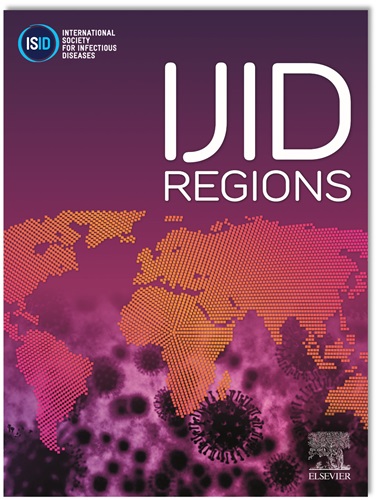Does wastewater surveillance have a role in vaccine-preventable disease control? Comparison of clinical and wastewater surveillance data for hepatitis A, E, measles, rubella and influenza viruses NICD, South Africa, 2021-2024
IF 4.8
2区 医学
Q1 INFECTIOUS DISEASES
引用次数: 0
Abstract
Introduction
Wastewater and environmental surveillance (WES) has provided valuable quantitation and sequencing data for polio, SARS-CoV-2 and Mpox to support public health decision-making. We aimed to determine if WES for vaccine-preventable diseases (VPDs) is possible and if it may complement clinical surveillance for hepatitis A, E, measles, rubella and influenza viruses.
Methods
Digital PCR (dPCR) assays using disease-specific primers were incorporated into single and multiplex reactions that were optimized using positive controls (viral culture, RNA plasmids or known clinical samples). Limits of quantification for each pathogen were determined using quantitative (qPCR) and dPCR on serial dilutions of positive controls. Retained concentrates from wastewater samples collected from 48 national wastewater treatment plants or district sampling networks in nine South African provinces for SARS-CoV-2 wastewater surveillance were subjected to batched RNA extraction and dPCR testing for VPDs. Results of wastewater testing and national notifiable medical conditions surveillance data were compared by epidemiological week and district of collection. Influenza wastewater results were compared with reference to the influenza season (during, before and after) as determined by clinical sentinel site surveillance data.
Results
Limits of quantification in genome copies/mL were as follows hepatitis A: 260; hepatitis E: 400; measles: 590; rubella: 460; influenza A&B: 1000. Amongst retrospective wastewater samples the proportion testing positive were; hepatitis A: 425/2329 (18%); hepatitis E: 280/2329 (12%), measles: 47/2422 (1.9%); rubella 39/2422 (1.6%), influenza A: 113/2422 (4.7%); influenza B: 72/2422 (3%). When compared with clinical results, wastewater results were positive when clinical cases were found in the same district and epidemiological week amongst 26%, 8%, 3% and 1% of time-district pairs for hepatitis A, E, measles and rubella respectively. However, the virus was detected in wastewater when no clinical cases were reported that week amongst 4%, 25%, 3% and 4% of time-district pairs for hepatitis A, E, measles and rubella respectively. Regarding influenza A, the majority of wastewater samples tested positive during the season (44/80 positive samples, 55%) than before or after, whilst the majority of influenza B detections in 2023 were after the season (28/36 positive samples, 77%)
Discussion
In our comparison of clinical and wastewater data for hepatitis A, E, measles and rubella, WES found evidence of circulating virus in wastewater on multiple occasions in districts when clinical surveillance failed to find cases. Clinical surveillance may be limited on account of test unavailability, absent health seeking, and cases being asymptomatic or minimally symptomatic. Public health action following wastewater detection in the absence of clinical cases should be determined by contextual factors (availability and coverage of vaccination, consequences of ongoing transmission, disease burden) and specific aims of disease control programmes.
Conclusion
Wastewater detection of vaccine preventable diseases is possible and may complement VPD surveillance and control programmes
废水监测是否在疫苗可预防的疾病控制中发挥作用?甲型肝炎、戊型肝炎、麻疹、风疹和流感病毒临床与废水监测数据比较,NICD,南非,2021-2024
废水和环境监测(WES)为脊髓灰质炎、SARS-CoV-2和Mpox提供了宝贵的定量和测序数据,以支持公共卫生决策。我们的目的是确定疫苗可预防疾病(VPDs)的WES是否可行,以及它是否可以补充甲型肝炎、戊型肝炎、麻疹、风疹和流感病毒的临床监测。方法采用疾病特异性引物进行数字PCR (dPCR)检测,采用阳性对照(病毒培养物、RNA质粒或已知临床样本)优化单反应和多反应。采用定量pcr和dPCR对阳性对照进行连续稀释,确定每种病原体的定量限。从南非9个省的48个国家污水处理厂或地区采样网络收集的用于SARS-CoV-2废水监测的废水样品中保留的浓缩液进行了批量RNA提取和vpd的dPCR检测。按流行病学周和收集区对污水检测结果与国家应报医学状况监测数据进行比较。将流感废水结果与临床哨点监测数据确定的流感季节(期间、之前和之后)进行比较。结果基因组拷贝数/mL的定量限为:甲型肝炎:260;戊型肝炎:400人;麻疹:590;风疹:460;流感A&;B: 1000。在回顾性废水样本中,检测阳性的比例为;甲型肝炎:425/2329 (18%);戊型肝炎:280/2329(12%),麻疹:47/2422 (1.9%);风疹39/2422(1.6%),甲型流感113/2422 (4.7%);乙型流感:72/2422(3%)。与临床结果比较,甲型肝炎、戊型肝炎、麻疹和风疹分别有26%、8%、3%和1%的时区对在同一地区和流行病学周发现临床病例时废水结果呈阳性。然而,当当周分别在4%、25%、3%和4%的甲型肝炎、戊型肝炎、麻疹和风疹时区对中没有临床病例报告时,在废水中检测到病毒。关于甲型流感,大多数废水样本在季节期间检测呈阳性(44/80阳性样本,55%),而2023年大多数乙型流感检测在季节之后(28/36阳性样本,77%)讨论在我们比较甲型肝炎、戊型肝炎、麻疹和风疹的临床和废水数据时,WES发现在临床监测未能发现病例的地区,废水中多次存在病毒循环的证据。临床监测可能会受到限制,因为无法获得检测,没有寻求健康,以及病例无症状或轻微症状。在没有临床病例的情况下,污水检测后的公共卫生行动应根据相关因素(疫苗接种的可得性和覆盖率、持续传播的后果、疾病负担)和疾病控制规划的具体目标来确定。结论废水中疫苗可预防疾病的检测是可行的,可作为VPD监测和控制规划的补充
本文章由计算机程序翻译,如有差异,请以英文原文为准。
求助全文
约1分钟内获得全文
求助全文
来源期刊
CiteScore
18.90
自引率
2.40%
发文量
1020
审稿时长
30 days
期刊介绍:
International Journal of Infectious Diseases (IJID)
Publisher: International Society for Infectious Diseases
Publication Frequency: Monthly
Type: Peer-reviewed, Open Access
Scope:
Publishes original clinical and laboratory-based research.
Reports clinical trials, reviews, and some case reports.
Focuses on epidemiology, clinical diagnosis, treatment, and control of infectious diseases.
Emphasizes diseases common in under-resourced countries.

 求助内容:
求助内容: 应助结果提醒方式:
应助结果提醒方式:


